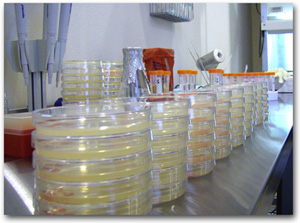USP <51> is used to test preservative effectiveness. The number “<51>” refers to General Chapter 51 of the United States Pharmacopeia (USP) National Formulary. Chapter 51 describes in detail the USP method for preservative efficacy testing, sometimes called “preservative challenge testing.”
 If you would like to learn more about the USP <51> preservative challenge test, you are in the right place! Below, you will find a summary of the USP <51> method, along with some of its strengths and weaknesses. Be sure to also read the page called “Getting the Most from Preservative Efficacy Testing.”
If you would like to learn more about the USP <51> preservative challenge test, you are in the right place! Below, you will find a summary of the USP <51> method, along with some of its strengths and weaknesses. Be sure to also read the page called “Getting the Most from Preservative Efficacy Testing.”
You are watching: USP 51 Antimicrobial Effectiveness Test
If you are a product formulator and would like Antimicrobial Test Laboratories to set up a preservative challenge test for you or your company, simply call the lab or click here to get a same day price quote.
Read more : Wholesale Snow Globes
Summary of the USP <51> Antimicrobial Effectiveness Test
- USP <51> challenges (inoculates) a formula with 5 different microorganisms, separately. Three bacteria and two fungal strains are used for each USP <51> test.
- Test microorganisms are grown in liquid or on solid medium, depending on the microorganism.
- Microorganisms used for a USP 51 test follow:
- Candida albicans (a yeast…yeasts are a form of fungus)
- Aspergillus brasiliensis (a filamentous mold…also a fungus)
- Escherichia coli (a bacterium…better known as “E. coli”)
- Pseudomonas aeruginosa (a bacterium….very problematic industrially)
- Staphylococcus aureus (a bacterium…better known as “Staph”)
- The test microorganisms are either harvested by centrifugation from broth culture or by washing surface growth from a solid medium into a sterile vessel.
- The concentrations of test microorganisms are standardized by resuspending harvested microorganisms in sterile saline to yield ~1 X 10^8 CFU/ml.
- A recovery analysis is performed to verify that microorganisms present in a sample can be adequately recovered and enumerated using the chosen dilution and plating scheme.
- A sufficient volume of test product (typically 10ml) is distributed into each of 5 separate containers, and each container is inoculated with a separate test microorganism (mentioned above).
- The initial concentration of viable microorganisms in the test product is determined by standard dilution and plate count methods.
- Inoculated test products are incubated at 22.5 ± 2.5°C and sampled to determine microorganism concentration at 7, 14 and/or 28 day intervals depending on the product category into which the formulation falls.
- The microorganism concentration at each interval is compared to the initial concentration, and then preservative effectiveness is determined based USP guidelines.
Strengths of the USP <51>Antimicrobial Effectiveness Test
- The USP 51 Antimicrobial Effectiveness Test specifies the initial target inoculum concentration, which allows for a fairly reproducible comparison of products that fall in the same product category.
- The USP 51 method challenges preserved products with a variety of microorganisms representing a broad spectrum of manufacturing, nosocomial and household contaminants, including gram-negative and gram-positive bacteria, yeast and mold.
- The initial inoculum concentration is relatively high, providing an indication of how the product will fare in “real life” should it be inadvertently contaminated with microorganisms during manufacturing or after sale.
Weaknesses of the USP <51> Antimicrobial Effectiveness Test
- The USP 51 test method covers a broad range of microbial physiologies and metabolic capabilities, but microorganisms may be encountered during manufacturing or normal consumer use that can defeat the preservative. For this reason, some customers choose to supplement USP 51 studies with separate inoculations of organisms that have proven problematic for them in the past.
- Antimicrobial effectiveness criteria with respect to C. albicans and A. niger is liberally defined across the 4 categories; a sample taken from 14 and 28 day intervals can have the same microorganism concentration as the initial inoculum, and still meet the “pass” criteria for these two microorganisms.

Antimicrobial Test Laboratories has a great deal of expertise in preservative efficacy testing, and in particular the USP <51> challenge test. Preservative tests run by the lab’s microbiologists are performed consistently to produce reliable results.
For more information about the <USP 51>Preservative Challenge Method, Contact the Lab Today!
Source: https://antiquewolrd.com
Categories: Stamps

